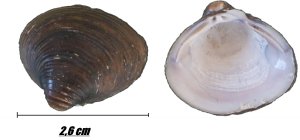A new study show that anthropogenic input of gadolinium into the rivers Rhine and Weser is not bioavailable to freshwater mussels.
Background: High-technology metals — such as the rare earth elements (REE) — have become emerging contaminants in the aquatic environment. Due to their low natural background concentration and their unique element signature, anthropogenic input can be followed through the waste water discharge into the rivers to the coastal sea and can even be used as a tracer for the contribution of surface water to drinking water.
Despite the significant pollution detected during the last decade in river and lake water worlwide, surprisingly little is known about the environmental behavior of these metals and their compounds. The Rhine River and the Weser River in Germany are two prime examples of rivers that are subjected to anthropogenic REE input from different sources. While both rivers carry significant loads of anthropogenic Gd, originating from contrast agents used for magnetic resonance imaging, the Rhine River also carries large amounts of anthropogenic La and lately Sm which are discharged into the river from an industrial point source.
The new study:

Photo: Corbicula fluminea (Asian clam)
inner- and outer side of the same mussel shell
(c) Wikipedia
|
Researchers from the Jacobs University Bremen in Germany now have assessed the bioavailability of these REE elements by analyzing the shells of freshwater mussels. Mussels have been used for more than 50 years for monitoring the contamination of the aquatic environment. While most researchers have used contaminant concentrations in the soft tissue, the concentration in their shells have also be employed for biomonitoring.
It has previously been shown that the REE distribution in marine mussel shells provides information on the REE distribution in the water in these mussels' respective habitats.
The researchers observed that the anthropogenic input of Gd to both rivers, resulting from its use as a contrast agent in medical imaging, and detectable in the river water by the so called Gd-anomaly in the REE concentration pattern, cannot be observed in the mussel shell. This indicates that the speciations of geogenic and anthropogenic Gd in the river water differ from each other and that the geogenic, but not the anthropogenic Gd is incorporated into the shells.
While the anthropogenic Gd input is diffuse and therefore shows up in a related Gd-anomaly over the whole length of the rivers, high amounts of La and Sm realeased from an industrial production site of fluid catalytic cracking catalysts, only show up as a related anomaly downstream of the point source. Interestingly, all shells sampled at sites downstream of this industrial point source show positive La and Sm anomalies, revealing that these anthropogenic REE are bioavailable.
 The new study:
The new study:
Gila Merschel, Michael Bau,
Rare earth elements in the aragonitic shell of freshwater mussel Corbicula fluminea and the bioavailability of anthropogenic lanthanum, samarium and gadolinium in river water, Sci. Total Environ., 533 (2015) 91–101.
doi: 10.1016/j.scitotenv.2015.06.042 Related studies
Related studies (newest first):

G. Klaver, M. Verheul, I. Bakker, E. Petelet-Giraud, P. Négrel,
Anthropogenic rare earth element in rivers: gadolinium and lanthanum.
Partitioning between the dissolved and particulate phases in the Rhine
River and spatial propagation through the Rhine-Meuse Delta (The
Netherlands), Appl. Geochem. 47 (2014) 186–197.
doi:
10.1016/j.apgeochem.2014.05.020.
Marvin Birka,
Christoph A. Wehe,
Lena Telgmann,
Michael Sperling,
Uwe Karst,
Sensitive quantification of gadolinium-based magnetic resonance imaging contrast agents in surface waters using hydrophilic interaction liquid chromatography and inductively coupled plasma sector field mass spectrometry, J. Chromatogr. A, 1308 (2013) 125–131.
doi:
10.1016/j.chroma.2013.08.017
S. Kulaksiz, M. Bau,
Anthropogenic dissolved and
colloid/nanoparticle-bound samarium, lanthanum and gadolinium in the
Rhine River and the impending destruction of the natural rare earth
element distribution in rivers. Earth Planet. Sci. Lett., 362 (2013)
43–50.
doi: 10.1016/j.epsl.2012.11.033. Lena Telgmann
Lena Telgmann,
Christoph Alexander Wehe, Marvin Birka, Jens Künnemeyer, Sascha Nowak,
Michael Sperling, and
Uwe Karst,
Speciation and Isotope Dilution Analysis of Gadolinium-Based Contrast Agents in Wastewater, Environ. Sci. Technol., 46/21 (2012) 11929-11936.
doi: 10.1021/es301981z
S. Kulaksiz, M. Bau,
Rare earth elements in the Rhine River, Germany:
first case of anthropogenic lanthanum as a dissolved microcontaminant in
the hydrosphere. Environ. Int., 37 (2011) 973–979.
doi:
10.1016/j.envint.2011.02.018.

G.L. Peltier, J.L. Meyer, C.H. Jagoe, W.A. Hopkins,
Using trace element concentrations in Corbicula fluminea to identify potential sources of contamination in an urban river. Environ. Pollut. 154 (2008) 283–290.
doi: 10.1016/j.envpol.2007.10.004.

M. Bau, P. Dulski,
Anthropogenic origin of positive gadolinium anomalies
in river waters. Earth Planet. Sci. Lett., 143 (1996) 245–255.
doi:
10.1016/0012-821X(96)00127-6.

J.K. Abaychi, Y.Z. Mustafa,
The Asiatic clam, Corbicula fluminea: an indicator of trace metal pollution in the Shatt al-Arab River, Iraq. Environ. Pollut., 54 (1988) 109–122. doi:
10.1016/0269-7491(88)90141-8.

A
nalytical instrumentation:
 PerkinElmer ELAN DRC-e ICP-MS
PerkinElmer ELAN DRC-e ICP-MS
 Related EVISA Resources
Related EVISA Resources
 Brief summary: ICP-MS - A versatile detection system for speciation analysis
Brief summary: ICP-MS - A versatile detection system for speciation analysis Brief summary: Speciation analysis for the study of metallodrugs and their biomolecular interactions
Brief summary: Speciation analysis for the study of metallodrugs and their biomolecular interactions Link database: Use of Gadolinium in pharmaceuticals
Link database: Use of Gadolinium in pharmaceuticals Link database: All about gadolinium
Link database: All about gadolinium
 Link database: All about lanthanum
Link database: All about lanthanum Link database: All about samarium
Link database: All about samarium Related EVISA News
Related EVISA News
 October 18, 2012: The behavior of Gd-based contrast agents during wastewater treatment
October 18, 2012: The behavior of Gd-based contrast agents during wastewater treatment April 17, 2009: Gadolinium-based MRI contrast agents found intact in the outlet of a waste water treatment plant
April 17, 2009: Gadolinium-based MRI contrast agents found intact in the outlet of a waste water treatment plant
last time modified: January 15, 2025